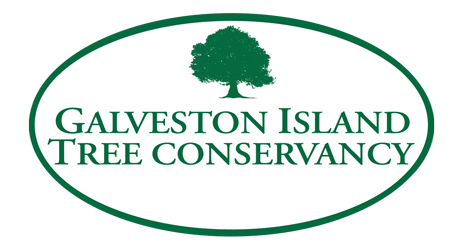Bur Oak
Tree Stories: Bur Oak
Oak trees are a favorite in home and public landscapes. Texas enjoys dozens of native oak species, ranging from small shrubs to giants over 100 feet tall. They flourish in arid western sites and oxygen-depleted wet areas in eastern Texas.
A relative newcomer to Galveston is the bur oak (Quercus macrocarpa), also known as overcup oak and mossy-cup oak. It has been part of Galveston NeighborWoods plantings since 2013. It often cross-pollinates with its close relative the white oak.
Everything is big about this tree. Its large multi-lobed dark green leaves can reach up to 6 by 10 inches in size. Its acorns are the largest of all native oaks—up to 2” long--inspiring the species name “macrocarpa” from the Latin meaning “large fruit”. The trees themselves can also become quite large under ideal conditions, reaching 75 feet on the Gulf Coast. Heavy branches form an open, spreading crown with thick and rough gray-brown bark that is fire protective. Leaves provide excellent shade in summer, dropping in winter to allow in sunlight and reveal the tree’s scaffolding.
This attractive tree thrives in a variety of soils and moisture conditions throughout eastern North America and can withstand a wide range of environments. It is one of the most drought resistant oaks but can also endure transient immersion. It enjoys sun or part shade and is both heat and cold tolerant.
Bur oak is reasonably fast-growing for an oak, with longevity perhaps exceeding 200 to 300 years. It is resistant to oak wilt and a number of other problems. Originally a prairie resident, it is now widely planted in urban settings because of its dense shade, and its resistance to air pollution and heat stress.
This oak has numerous uses. Acorns are edible after tannins are leached and can be used in flour, baking, and soups, and even as a so-so coffee substitute. Native Americans used bark decoctions as medication for heart problems, wounds, insect bites, and many other ailments. Woodworkers value the extremely hard wood and use it for construction, flooring, and cooperage.
Wildlife also appreciate this tree. It attracts a variety of birds and numerous small mammals for food and habitat and provides larval food for several species of butterflies.
The National Register of Big Trees reports that removal of a bur oak 60 feet tall would require expenditures of $3500 to replace the stormwater control service it provides. This same tree removes 19.56 lbs. of nitrogen, sulfur, ozone and particulate matter every year.
Bur oak is a splendid and tough landscape tree worthy of consideration for planting in parks, large yards, and other open areas. While not likely to reach maximum size here, it should be planted in a space that can accommodate a big tree. It is available commercially or you can grow your own from a huge acorn. See some lovely examples of young specimens planted in 2013 in the 3700 block of Avenue P½ and 4100 block of Avenue Q.
Margaret Canavan is a Galveston resident, a Certified Master Gardener, and a member of the Board of the Galveston Island Tree Conservancy.

